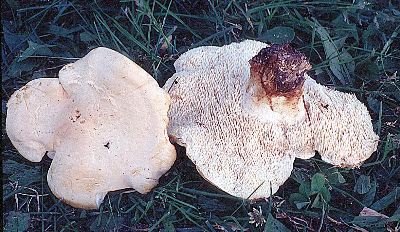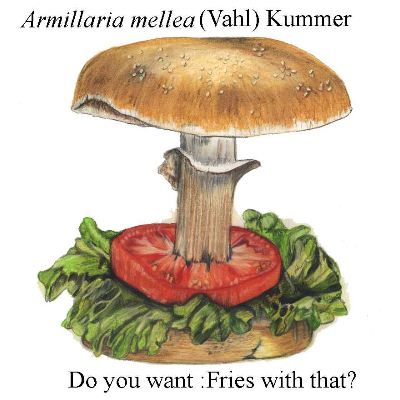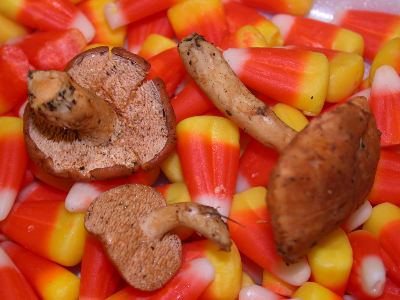Do you remember the good old days when you could go trick-or-treating for Halloween and, instead of razor blades, your really nice neighbors would give you a handful of candy corn for your sack? Well what if they gave you some sweet tooth mushrooms instead? Would you be grateful? You should be! This month's fungus, Hydnum umbilicatum and the larger Hydnum repandum are some of the most delicious of the edible fungi, prized for their somewhat sweet taste and bug-free existence. They're also very firm and have a great chewy (but not-too-chewy) texture. It's a joyful day when you find lots of sweet tooths (sweet teeth?), although maybe you wouldn't have appreciated them in your trick-or-treat pillowcase. Remember that Charlie Brown did not appreciate his treat, saying "I got a rock."
Hydnum is one of the tooth fungi, although unrelated to other tooth fungi such as Hydnellum caeruleum, the blue and orange Hydnellum or Hericium americanum, the icicle mushroom or pom-pon mushroom. The genus Hydnum is separated from the rest of the genera of stipitate tooth fungi by its mushroom shape, smooth white spores, determinate growth, and mycorrhizal habit. Typically we find Hydnum species with oak, but occasionally with conifers, such as spruce and pine. It's a happy mushrooming day when you can find lots of these. They're really one of my very favorite mushrooms to eat, and they keep almost forever (well, at least 3 weeks) in a sealed container in the refrigerator. Their delicious flavor reminds me of chanterelles-- hmmmmmmm.....more on this later.
As I described on this page about Hericium, the tooth fungi were once all placed in the genus Hydnum, but we now consider them to belong to at least 43 other genera. Interestingly, recent molecular evidence has placed Hydnum with the chanterelles (!), especially close to Cantharellus cibarius, the orange chanterelle, but possibly also with Craterellus fallax, the black chanterelle. For most people, this was quite a surprise, but it makes sense when you think about it. Both genera have white smooth spores and a mycorrhizal habit. Their culinary characteristics are similar in that both are somewhat sweet in taste and fruity in fragrance. In addition, they are both fairly resistant to insect damage and colonization, although Hydnum seems to be much more resistant to bugs than the chanterelles.
 Hydnum umbilicatum is probably the least prized of the Hydnum species. Although usually delicious, it takes a lot more bending down to pick these scattered mushrooms to get enough for a meal. There are also reports that some populations of this species have a foul or bitter taste. Just like tomatoes and strawberries, flavor can vary greatly among strains or populations. You might want to test a few of the Hydnum's that you pick before committing a whole meal to them.
Hydnum umbilicatum is probably the least prized of the Hydnum species. Although usually delicious, it takes a lot more bending down to pick these scattered mushrooms to get enough for a meal. There are also reports that some populations of this species have a foul or bitter taste. Just like tomatoes and strawberries, flavor can vary greatly among strains or populations. You might want to test a few of the Hydnum's that you pick before committing a whole meal to them.
There are actually several larger species of Hydnum in North America. The most prized is Hydnum repandum, also known as the hedgehog mushroom (for its bristly teeth). We sometimes find this species (shown to the right) in great abundance in the Upper Peninsula of Michigan at our more-or-less annual Mushroom Workshop. They're really big there, too, about 9-12 inches (20-30 cm) in diameter-- or larger! In a good year, we can fill a grocery bag in half an hour. Them's good eatin'!
In the southeastern USA, I have also found Hydnum albidum, which is somewhat paler and intermediate in size, as shown below. The teeth also seem to be longer in comparison with the size of the fruiting body. It reportedly has much the same flavor as the other Hydnum species, although I have never eaten it. I guess I need to go south again soon! 
You may have learned this species as Dentinum umbilicatum and the hedgehog mushroom as Dentinum repandum. Why do we now accept Hydnum and not Dentinum? In order to understand you must know a little about the concept of "type specimens" and "type species" in fungal nomenclature.
There are very specific rules for naming a new species. The taxon must be a previously undescribed and it must have a Latin description or diagnosis (since 1935). In addition, since 1953, there must be a designated type specimen with the location where it will be kept . Usually it is an actual dried fungus that represents the published name, but for older descriptions there may only be a picture (often a beautiful painting), or a reference to someone else's picture. Much of the International Code of Botanical Nomenclature (ICBN) of over 100 pages deals with very specific rules with examples to assist taxonomists, keeping them from making mistakes or accounting for inconsistencies in the literature before the code was put into place. For example, the description must be validly published in an accepted journal or other scientific location, and the name cannot have been previously used. Rules for renaming a genus or species are also very specific. If the species is validly published, the original epithet must be used; the basionym (original name) and place of publication must be listed; and the newly recombined name cannot have been previously used. These are oversimplifications, but you get the general idea that name changes are not done frivolously. But I digress...
Anyway, so now you understand the concept of the type species. The same principle applies to the type species of a genus, the type genus of a family, the type family of an order, and so on. The ICBM defines the concepts of the type and the type species:
- Art. 7.2. A nomenclatural type (typus) is that element to which the name of a taxon is permanently attached, whether as a correct name or as a synonym. The nomenclatural type is not necessarily the most typical or representative element of a taxon.
- Art. 10.1. The type of a name of a genus or of any subdivision of a genus is the type of a name of a species (except as provided by Art. 10.4). For purposes of designation or citation of a type, the species name alone suffices, i.e., it is considered as the full equivalent of its type.
So, how does that relate to our discussion of Dentinum vs. Hydnum? We need to look at some very old literature, probably before you were even born-- and probably before your great grandparents were born. Much of this information comes from Ron Peterson's work.
We have to go back to 1718 and 1719), when a German Botanist named Johann Jakob Dillenius erected the monotypic (one species) genus Erinaceus and included a description for both the genus and one species. This species description matches the present-day species Hydnum repandum. In his work Species plantarum (Species of Plants, 1753), Swedish botanist Carolus Linnaeus, a.k.a. Karl von Linné accepted Dillenius' concept but changed the name Erinaceus first to Hydna and then to Hydnum and added more species. Linnaeus's work is considered the starting point to all of plant and fungal taxonomy.
 Another Swedish botanist, Elias Magnus Fries (1821), later accepted Linnaeus' concept of Hydnum and also included more species. Fries is considered to have "sanctioned" a name if it appears in his seminal publication Systema mycologicum in 1821. Therefore, because Fries (1821) based the genus Hydnum after Linnaeus, and Linnaeus accepted Hydnum as the new name for Dillenius' genus Erinaceus, Hydnum repandum L:Fries is the only choice as the type species of Hydnum L.:Fries. Note that the sanctioning of the name by Fries is denoted by the colon L:Fries, which indicates that Fries sanctioned Linneaus' name Hydnum in 1821. Since the ICBN has pushed the starting date for fungal nomenclature back to Linneaus (1753), there is some controversy about whether we need to include Fries' sanctioning of names at all. The drawing, by my former student Kelly Collins (about to get her Ph.D. in Mycology at Oregon State), depicts the controversy using Armillaria mellea (Vahl:Fries) Kummer.
Another Swedish botanist, Elias Magnus Fries (1821), later accepted Linnaeus' concept of Hydnum and also included more species. Fries is considered to have "sanctioned" a name if it appears in his seminal publication Systema mycologicum in 1821. Therefore, because Fries (1821) based the genus Hydnum after Linnaeus, and Linnaeus accepted Hydnum as the new name for Dillenius' genus Erinaceus, Hydnum repandum L:Fries is the only choice as the type species of Hydnum L.:Fries. Note that the sanctioning of the name by Fries is denoted by the colon L:Fries, which indicates that Fries sanctioned Linneaus' name Hydnum in 1821. Since the ICBN has pushed the starting date for fungal nomenclature back to Linneaus (1753), there is some controversy about whether we need to include Fries' sanctioning of names at all. The drawing, by my former student Kelly Collins (about to get her Ph.D. in Mycology at Oregon State), depicts the controversy using Armillaria mellea (Vahl:Fries) Kummer.
So, where does Dentinum come from? It's really just a matter of timing that we don't use that name-- he who publishes first get to name the species. Although Dentinum was published by Englishman S.F.Gray (1821) the same year as Fries (1821), his work is considered to postdate that of Fries. Therefore, Dentinum repandum cannot be used as the name for this species because the type of Hydnum was established with Dillenius' Erinaceus and Linnaeus' Hydnum. This leaves the name Sarcodon as the earliest available name for the dark spored stipitate hydnums. Got a headache yet?
I hope you enjoyed learning something about Hydnum and the rest of the tooth fungi-- and maybe even a little about fungal nomenclature. Anyway it will give you something to think about as you hunt for these delicious mushrooms the next time you're in the woods.
If you have anything to add, or if you have corrections, comments, or recommendations for future FotM's (or maybe you'd like to be co-author of a FotM?), please write to me at volk.thom@uwlax.edu
This page and other pages are © Copyright 2004 by Thomas J.
Volk, University of Wisconsin-La Crosse.
Learn more about fungi! Go to Tom Volk's Fungi Home Page --TomVolkFungi.net
Return to Tom Volk's Fungus of the month pages listing

